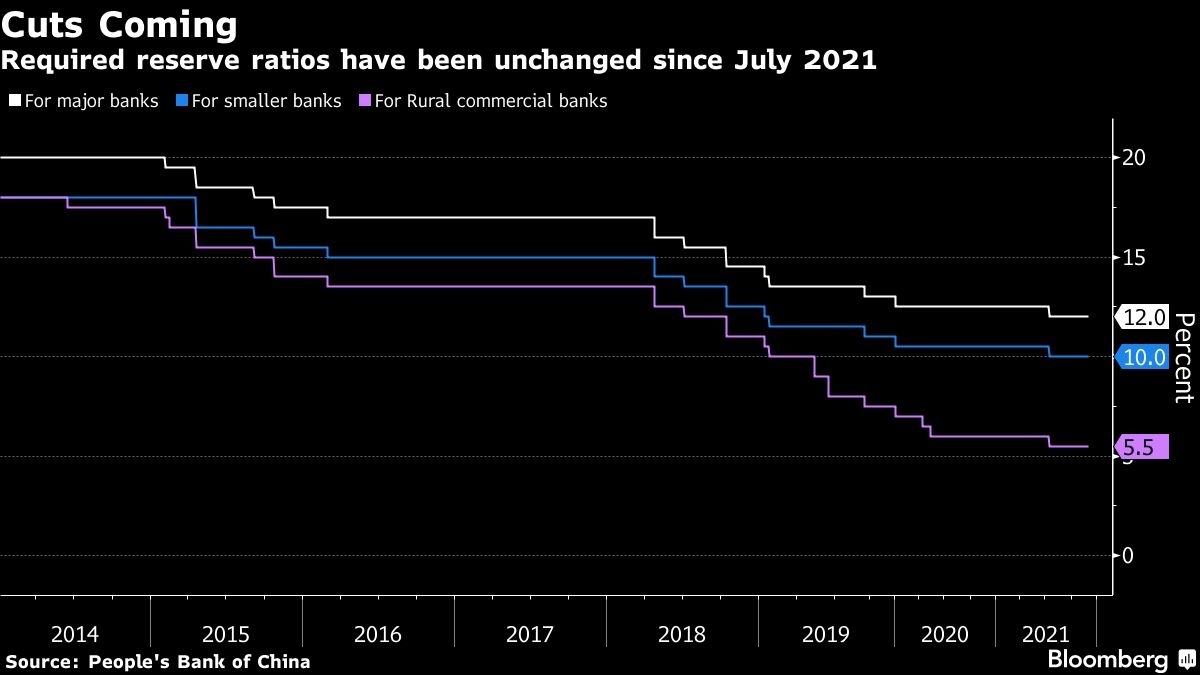Dec 6, 2021
China cuts reserve requirement ratio as economy slows
Bloomberg News
Credit Suisse PB Is 'Neutral' on China, Sia Says
China cut the amount of cash most banks must hold in reserve, acting to counter the economic slowdown in a move that puts the central bank on a different policy path than many of its peers.
The People’s Bank of China will reduce the reserve requirement ratio by 0.5 percentage point for most banks on Dec. 15, releasing 1.2 trillion yuan (US$188 billion) of liquidity, according to a statement published Monday.
The reduction was signaled by Premier Li Keqiang last week when he said that authorities would cut the RRR at an appropriate time to help smaller companies, and is the second reduction this year. The decision comes after recent data showed the economy and industry stabilizing, although Beijing’s tightening curbs on the property market have led to a slump in construction and worsened a liquidity crisis at developer China Evergrande Group and other real-estate firms.
The cut is a “regular monetary policy action,” the PBOC said, pre-empting expectations that the decision was the start of of an easing cycle. “Prudent monetary policy direction has not changed,” it said, adding that the bank “will continue with a normal monetary policy, maintaining the stability, consistency and sustainability of policy, and won’t flood the economy with stimulus.”
However, with the U.S. Federal Reserve and other global central banks looking to tighten policy, the move to add stimulus by the PBOC makes the divergence between China and much of the rest of the world even clearer.

What Bloomberg’s Economists Say
“We think the reduction would help offset the headwinds facing the economy, particularly in the first quarter of 2022. We maintain our view that an additional 50-100 basis points of RRR cut would come next year.”
- David Qu, economist
Separately, the Communist Party’s Politburo said China will continue to implement a proactive fiscal policy in 2022, and prudent monetary policy will be flexible and appropriate, and maintain reasonably ample liquidity, the official Xinhua News Agency. The Monday meeting of the Politburo will be followed by the Central Economic Work Conference sometime this month, which will flesh out economic policy plans for the next year.
The cut will be applied to all banks except those that are already on the lowest level of 5 per cent, which are mostly small rural banks, according to the statement. The weighted average ratio for financial institutions will be 8.4 per cent after the cut, down from 8.9 per cent previously, the PBOC said in a separate statement.
Some of the money released by the RRR cut will be used by banks to repay maturing loans from the PBOC’s medium-term lending facility, and some of it will be used to replenish financial institutions’ long-term capital, the central bank said. There are almost 1 trillion yuan worth of the 1-year loans maturing on Dec. 15, the day the cut takes effect.
Even with the deepening housing market slump, authorities had been restrained in adding new support policies, holding monetary policy steady and maintaining a measured pace of fiscal spending. However, the PBOC signaled an easing bias in the latest monetary policy report last month, while the State Council urged local governments to speed up spending.
“The aim of the RRR cut is to strengthen cross-cyclical adjustment, enhance the capital structure of financial institutions, raise financial services capabilities to better support the real economy,” the PBOC said. The cut will effectively increase long-term capital for banks to serve the real economy, and the PBOC will guide banks to step up their support for small businesses, it said.
A cut in the reserve ratio doesn’t directly lower borrowing costs, but quickly frees up cheap funds for banks to lend. The reduction will lower the capital cost for financial institutions by about 15 billion yuan each year, which will lower the overall financing cost of the economy, the PBOC said.

